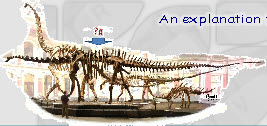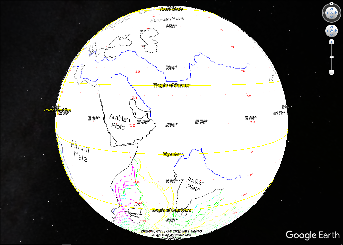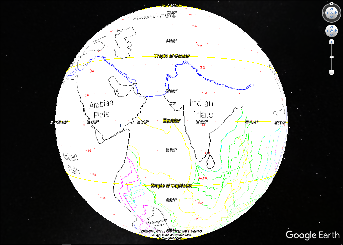


I’ve updated my Global Tectonics Program to export the palaeographic maps as Google Earth overlays. Assuming you have Google Earth installed you can simply view the kmz file by clicking on this link and following the prompts.
Once the file is loaded you will be able to compare reconstructions based on the two competing theories of Plate Tectonics and Expansion Tectonics. For example: the two screen shots (shown below) illustrate how the two different theories predict different positions for the Indian plate 60 million years ago. All these differing predictions are easily compared using the overlays.
Once the file is loaded you will be able to compare reconstructions based on the two competing theories of Plate Tectonics and Expansion Tectonics. For example: the two screen shots (shown below) illustrate how the two different theories predict different positions for the Indian plate 60 million years ago. All these differing predictions are easily compared using the overlays.
Share this page

In more detail: The kmz file should rapidly download since it is very small. Save and then Open the file. When you open the file it should automatically appear in Temporary Places in Google Earth. Use View/Sidebar dropdown menu if your sidebar isn’t visible.
Open the “Paleographic Reconstructions-Cloud” file within Google Earth and the option to view Plate Tectonic or Expansion Tectonic reconstructions becomes available. Opening Plate Tectonics will allow access to views of conventional Plate Tectonics Reconstructions from 0 to 210 Ma (Million years ago). Opening Expansion Tectonics will allow views of the newer Expansion Tectonics from 0 to 210 Ma. Select the age you wish to view.
It is possible to flick from a Plate Tectonic Reconstruction to an Expansion Tectonic Reconstruction of the same age to easily compare them. For example: a comparison of a Plate Tectonic Reconstruction at 30 Ma can easily be compared with an Expansion Tectonic Reconstruction at 30 Ma by clicking the overlay on and off. Since this is a “work-in-progress” the Google Earth file automatically updates itself by loading the latest version every time it runs.
When you close Google Earth it will prompt you to save the file in your “My Places” folder. Once saved it will be available in your My Places whenever you open Google Earth, although you will still need an Internet connection of course.
Comment on this page on Facebook
Related Pages
Open the “Paleographic Reconstructions-Cloud” file within Google Earth and the option to view Plate Tectonic or Expansion Tectonic reconstructions becomes available. Opening Plate Tectonics will allow access to views of conventional Plate Tectonics Reconstructions from 0 to 210 Ma (Million years ago). Opening Expansion Tectonics will allow views of the newer Expansion Tectonics from 0 to 210 Ma. Select the age you wish to view.
It is possible to flick from a Plate Tectonic Reconstruction to an Expansion Tectonic Reconstruction of the same age to easily compare them. For example: a comparison of a Plate Tectonic Reconstruction at 30 Ma can easily be compared with an Expansion Tectonic Reconstruction at 30 Ma by clicking the overlay on and off. Since this is a “work-in-progress” the Google Earth file automatically updates itself by loading the latest version every time it runs.
When you close Google Earth it will prompt you to save the file in your “My Places” folder. Once saved it will be available in your My Places whenever you open Google Earth, although you will still need an Internet connection of course.
Comment on this page on Facebook
Related Pages
Introduction to the Global Tectonics Program
More detail about the Global Tectonics Program
More detail about the Global Tectonics Program
Further Reading
Download Google Earth Pro here
A Brief History of the Expanding Earth theory here
The probability of the Expanding Earth here
Latest News, Comments and Updates here
My book details here
Reviews for my book here
A Brief History of the Expanding Earth theory here
The probability of the Expanding Earth here
Latest News, Comments and Updates here
My book details here
Reviews for my book here
Page first created 05 Apr 17
Page last updated 10 Jan 19

Plate tectonics reconstruction at 60 Ma
Expansion tectonics reconstruction at 60 Ma
A Youtube video showing how to load the palaeographic maps on Google Earth




